The Secrets of Soil
A reflection on the November 2014 Soil Food Web Course I attended taught by Dr. Elaine Ingham
Soil excites me. As I started to explore the world of Permaculture, I realized that everything starts with Soil. This has led me to learn as much as I can about each microbe that resides under our feet, and their relationship to one another.
As a species, we have sent people to the moon, but we have only just scratched the surface when it comes to understanding Soil biology.
My fascination with Soil sent me soaring to San Diego, and in November 2014 I participated in a course on the Soil Food Web, with one of the world’s leading soil microbiologists, Dr Elaine Ingham.
This was 5 days of intense education, as we delved deep into the science of soil, making thriving thermal compost, producing effective compost tea and identifying intriguing microbes during our day of microscopy.
The Soil Food Web is the foundation of Elaine’s teachings, and what stood out most during these lectures was that her studies have shown there is no need to rely on chemical tests or fertilizers when it comes to improving mineral content in the soil; the minerals are already present, it is the microbes which ensure these minerals are available to the plant.
The bacteria, fungi, protozoa, nematodes and microarthropods store plant available nutrients in a process known as immobilization. This means that, just like our food is immobilized within our bodies when we eat it, and made plant available through our composted manure (if we let it!), so are the nutrients retained in the bodies of microorganisms and released within the root zone of the plant through either waste metabolite or nutrient exchange.
Nutrient exchange is often a trait of fungi, as they exchange nutrients with plants, bacteria and other species of fungi in exchange for carbohydrates.
The Soil Food web is a complex world; just as you see a forest above ground, there is an underground ecology waiting for our care and remediation.
Most of what we see now is in fact dirt (not soil), devoid of biological life and thus unable to exchange nutrients effectively.
Soil treatment starts with one thing- Compost!
Compost contains lots of organic matter that feeds the soil organisms, ensuring rapid response time between plants and microbes which encourages dynamic growth.
To make compost which breeds aerobic bacteria, rather than anaerobic bacteria (which a lot of the time are pathogenic) a few factors need to be considered, monitored and maintained; Size, Material, Ratios of Material, Water, Temperature, and Turning.
If we get the mix right, our compost will be a delicious, thriving mass of microbial life; and the more diverse the microbes, the more regular and varied the diet of plants growing within that compost will be.
The information gleaned during the course was as complex as the soil microbes themselves, although Elaine’s facilitation allowed for easy digestion. Elaine Ingham is passionate and driven, which shows in her work as she tries to tackle one paddock of dirt at a time, be that through microscopy, research, compost, or education.
I believe in order to be truly regenerative, we must cycle our nutrients with care, responsibility and thoughtful action based on thorough research.
The next generation, be that plant or animal, will rely on ecological diversity, both above and below ground.

